![]()
![]()
![]()
Use LEFT and RIGHT arrow keys to navigate between flashcards;
Use UP and DOWN arrow keys to flip the card;
H to show hint;
A reads text to speech;
75 Cards in this Set
- Front
- Back
|
The gradient recalled Echo GRE initially uses _____ to excite the protons |
Flip angle less than 90° |
|
|
The GRE sequence uses a gradient ___ pulse to rephase the protons |
Instead of a 180°RF |
|
|
GRE uses any flip angle (variable) or partial flip |
Smaller angle=smaller signal Can: dephrase and rephrase proton spins |
|
|
Timing is everything! if gradient is turned on when protons are in-phase Gradient on= ____ |
GRE dephasing |
|
|
If a gradient is applied to incoherent protons, they will become in-phase Gradient on= _______ |
GRE rephrasing |
|
|
A spolier pulse may be applied to destroy residual transverse magnetization prior to the next pulse Can be RF or gradient spoiler pulse What is this called? |
Incoherent or "spoiled" gradient echo |
|
|
A gradient can continually rephrase the protons, keeping them in a "steady state" |
Incoherent or "steady state" |
|
|
What is the difference between incoherent and coherent gradient echo? |
Incoherent is "spoiled" and coherent is "steady state" Incoherent or spoiled gradient echo can be RF or gradient spoiler pulse. A spoiler pulse may be applied to destroy residual transverse magnetization prior to the next pulse. Coherent or steady state gradient echo is a gradient that can continually rephrase the protons, keeping them in a steady state |
|
|
Gradients that rephrase are called _____ |
Spoilers. Spoiler squashes the signal |
|
|
What is the difference of SE vs. Gradient echo |
Spin echo -initial 90° pulse -180° pulse used to refocus Mxy and create echo (transverse magnetization) -produces pure T2 contrast Gradient echo -uses a gradient reversal to refocus Mxy (transverse magnetization) -ONLY can produce T2* contrast, not T2. T1 and PD -Spoilers RF pulse or gradient (spoiled GRE) |
|
|
What is this called? -Initial 90°pulse -180° pulse used to refocus Mxy and create echo (transverse magnetization)-produces pure T2 contrast |
Spin echo |
|
|
What is this called? -initial low flip angle <90° -uses a gradient reversal to refocus Mxy -ONLY can produce T2* contrast, not T2. T1 and PD. -Spoiler RF pulse or gradient (spoiled GRE) -shorter TR, shorter TE |
Gradient echo |
|
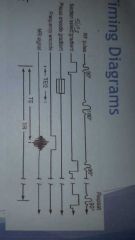
Long TR Short TE |
Spin echo |
|
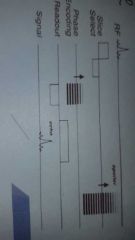
No 180° pulse! Faster sequence |
Gradient echo |
|
|
A gradient echo has + shorter TEs and no ____? |
180° RF pulse |
|
|
Gradient echo has shorter TRs and smaller ___? |
Flip angles |
|
|
Gradient echos are shorter overall ____? |
Scan time |
|
|
Gradient echos don't compensate for ___? |
Inhomogeneities |
|
|
What is the difference CSE and GRE? |
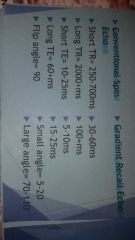
|
|
|
A CSE (conventional spin echo) parameter |
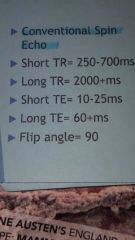
|
|
|
A gradient recall echo parameter |

|
|
|
Dephasing is caused by 4 mechanism |
1. Spin-spin interactions 2.magnetic field inhomogeneities 3. Magnetic susceptibility 4. Chemical shift |
|
|
These four mechanisms are caused by ____? 1. Spin-spin interactions 2.magnetic field inhomogeneities 3. Magnetic susceptibility 4. Chemical shift |
Dephasing |
|
|
What are the spin-spin interactions? |
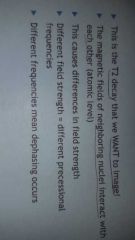
|
|
|
What are the magnetic field inhomogeneities? |

|
|
|
Magnetic susceptibility |

|
|
|
Chemical shift |

|
|
|
When a gradient is applied, phase accumulated. This is the principle of _____? |
The Phase Encoding Gradient |
|
|
Balancing gradients foe phase. -If an equal and opposite gradient is applied, protons rephrase which equals |
NO NET PHASE SHIFT |
|
|
Balancing gradients for phase. -this is an important part of gradient echo sequences |
We must balance the slice select gradient and the frequency encoding gradient for phase so that the ONLY phase difference is from phase encoding!! |
|
|
How are gradients balanced for phase? |
-When a gradient is applied, phase accumulates (principle of phase encoding gradient) -if an equal and opposite gradient is applied, protons rephrase=no net phase shift -balance the slice select gradient and the frequency encoding gradient for phase so that the ONLY phase difference is from phase encoding |
|
|
How are gradients dephased? |
-in a GRE sequence, the gradient is applied in one orientation to help the protons dephase faster so that they can be rephased faster |
|
|
-in a GRE sequence, the gradient is applied in one orientation to help the protons dephase faster so that they can be rephased faster. Why does this work? |
Different field strength = different precessional frequency
-the slower protons get behind |
|
|
How do gradients rephase? |
When the gradient orientation is reversed, the slower protons now speed up and the faster ones slow down -they eventually catch up and all are in phase again |
|
|
Important points on how gradients rephase |
A gradient cannot selectively rephase- ALL types of T2 and T2* dephasing are rephased! |
|
|
Another important point to how gradients rephase |
A GEE sequence can ONLY have T2* weighting!!! And no T2 is produced |
|
|
Remember... |
The 180°RF pulse in a r Spin echo in a spin Echo sequence rephases everything except the true T2 dephasing |
|
|
What are the advantages of GEE sequences? |
1. Much faster sequences. Less RF energy deposited than spin Echo due to no 180° RF pulse 2. Lower SAR due to no 180° RF pulse. 3. Can be used for breath-hold sequences due to fast times. 4. Sensitive to flow, so can be used to create angio-type images.
|
|
|
Balancing gradients for phase |

|
|
|
What are GRE disadvantages? |

|
|
|
Fast Gradient Echo is also known as |
Prepared rapid gradient echo sequence |
|
|
Fast Gradient Echo is fast or slow for breath hold exams? |
Very fast foe breath hold exams |
|
|
Fast Gradient Echo sequence uses ___? |
T1 or T2 contrast |
|
|
Fast Gradient Echo uses 90° and/or 180° pulse combinations to ___? |
To prepare the contrast before the pulse sequence begins (Similar to invasion recovery) |
|
|
What does it mean when ALL echos are collected? |
It means that contrast is changing as echoes are taken |
|
|
Fast Gradient Echo sequences uses echo reordering in ___space to obtain desired contrast |
K-SPACE |
|
|
Single shot EPI uses single excitation pulse to ____? |
To acquire an entire image |
|
|
Single shot EPI -readout gradient is switched in ___ fashion? |
Bipolar |
|
|
Single shot EPI Within the FID it generate an entire echo train of ____ and ____ gradient echoes |
Ascending and descending |
|
|
Single shot EPI The number of gradient echoes is the ___? |
EPI factor |
|
|
Single shot EPI must be fast due to T2* ____? |
Decay (100ms) |
|
|
Single shot EPI Readout is limited to between ___ and ___ echoes |
64 and 128 echoes |
|
|
Single shot EPI The effective echo time TEeff coincides with the ___ signal |
Maximum |
|
|
Single shot EPI Think about it--128 echoes at 100 ms=128000 ms or just ___? |
12.8 seconds |
|
|
What is this called. Multiple phase encoding during multiple gradient recalled echoes |
Echoplanar imaging |
|
|
What are the pros of echoplanar imaging |
1. EPI is a phase encoding scheme and can be combined with many spin preparation methods 2. Very fast with new technology (Single image in 50ms) |
|
|
What are the cons of echoplanar imaging? |
1. Expensive technology 2. Requires fancy reconstruction schemes to correct artifacts 3.intrincially T2* weighted due to the use of gradients to rephase 4. Rapidly switching gradients introduce another safety concern- direct neural stimulation (TVMF, peripheral nerve stimulation, magnetophosephenes |
|
|
What is saturation? |
Anytime the NMV is pushes beyond 90° the tissue is said to be partially saturated -partial saturation leads to decreased signal |
|
|
What is Saturation if the NMV Flip all the way to 180° |
It is fully saturated -full saturation leads to zero signal -this can occur after repeated excitation of any tissue=signal fall off over time |
|
|
Why is Saturation useful? |
Because of the spatial (A portion of the anatomy you don't want to see) and chemical shift (specific tissue) |
|
|
What are the two main types of saturation pulses? |
1. Spatial saturation= selectively excites protons due to their location 2. Chemical saturation= selectively excites protons due to their unique frequencies |
|
|
What is spatial saturation? |
selectively excites protons due to their location |
|
|
What is chemical saturation? |
selectively excites protons due to their unique frequencies |
|
|
What is an advantage of spatial saturation pulses? |
Nulls signal from unwanted or moving anatonomy |
|
|
What are the disadvantages of spatial saturation pulses? |
-additional 90°RF pulses increase time -increased use of RF energy increases SAR |
|
|
Unwanted anatomy Spatial saturation pulses. Let's say you want to decrease the signal coming from the throat during as sagital c-spine. Place a ___? |
Saturation pulse, Sat band on the anterior neck -this applies a 90° pulse selectively to that region by using the gradients (just like in slice selection) -the next 90° pulse is the normal excitation pulse for the rest of the tissue, but for the pre-excited tissue it is now thrown into 180° saturation |
|
|
What are the 4 chemical saturation pulses for fat suppression? |

|
|
|
Fat suppression short TI inversion recovery |
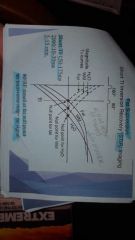
|
|
|
What are the two methods for fat suppression? |
1. Fat saturation 2. STIR |
|
|
What are the 3 main points for fat saturation? (Fat suppression method 1) |
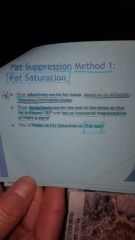
|
|
|
Frequency difference between fat and water |
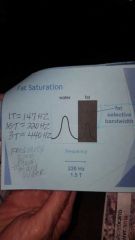
1T=147 HZ 1.5T =220 HZ 3T=440 HZ |
|
|
Fat saturation image |
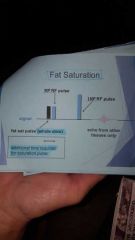
|
|
|
What are the advantages of fat saturation? |
1. Increased appearance of fluid on T2 weighted image (widens dynamic range) 2. Addresses TSE fat-fluid isointensity problem 3. Post gadolinium t1-weighted fat SAT (negating fat signal shows contrast enhancement better) 4. Reduced respiratory motion artifact |
|
|
Fat saturation disadvantages |
1. Fewer slices per TR (adding a saturation pulse prolongs effective interval) 2. Higher SAR due to more RF energy being applied 3. Requires homogeneous magnet (shimming takes time) 4. Requires uniformly shaped body part ( doesn't work well at base of neck, crook of ankle,etc.) 5. Not recommended with field of view higher than 30 centimeters (unreliable) ( edges of anatomy less well saturated due to distance from ISO Center) 6. Works poorly at lower Fields due to less difference in fat frequency 7. SNR drops |
|
|
What are 4 main points for fat suppression method 2: STIR |

|

